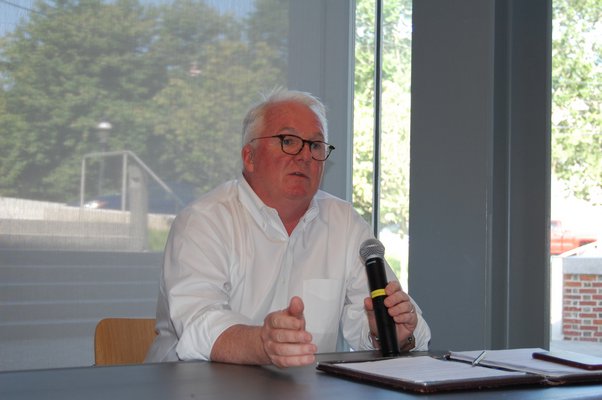
Local Law 12, the controversial measure that the Sag Harbor Village Board adopted last year in an effort to encourage more affordable apartments in its office and village business zoning districts, is going to be subjected to a review from both the board and the public.
Trustee Aidan Corish made the recommendation on Tuesday, February 14, at a Village Board meeting. “There is a growing sense of unease that Local Law 12 will allow for unfettered development,” he told his colleagues.
He added that he had been asked by a number of residents to take a second look at the law and asked the board to create committee to do so. “It’s vital that the residents of the village have confidence in the laws we pass on their behalf,” Corish said.
Immediately after the board adopted the law last June, developer Adam Potter unveiled plans for a 79-unit affordable apartment and commercial complex on a parcel bounded by Bridge and Rose streets. Shortly afterward, Save Sag Harbor, arguing the village had taken short cuts in its environmental review of the law, challenged it in court.
Trustee Ed Haye, an attorney who helped draft the law, said that because of that lawsuit, board members had been reluctant to speak about the law in public. “But that doesn’t mean the law shouldn’t be further clarified and the public doesn’t deserve a greater understanding of the law that is currently out there,” he said.
He called for a two-part effort that would invite Village Attorney Elizabeth Vail to explain how the law “interacts with the rest of the code,” and then invite comment from the public.
Resident Kathryn Levy said the law was subjected to inadequate public review when the board unveiled it last spring. “A law that is as consequential as Local Law 12 to our future should be the subject of months of discussion and debate and examination by the community,” she said. “It shouldn’t be the subject of public comment at three regular Board of Trustees meetings.”
Levy called for the board to repeal the law and start all over. “I think the law is riddled with problems and riddled with opportunities for developers to fundamentally change our village in a bad way,” she said, referring to Potter’s Bridge Street proposal.
Architect Anthony Vermandois took a more measured approach, saying there were three specific changes he would make to the law. The first would be to limit the number of properties that could be combined to create affordable housing, which, he said, would have prevented someone like Potter from buying up an entire block for redevelopment. Second, he said, the board should impose a limit on the number of affordable apartments that can be included in any development.
“I don’t know if that limit should be five units or 50 units,” he said. “It certainly shouldn’t be 79 units.”
Finally, Vermandois suggested that the village decrease the allowable minimum size for an affordable apartment from 500 to 400 square feet, a measure, he said, that would provide developers with more flexibility.
Although the board agreed the review of Local Law 12 would be valuable, it did not set a date for the forum.
It did, however, agree to hold three public hearings next month on other measures. One would eliminate a provision in the Waterfront Overlay District that was established in 2021 allowing buildings to be as tall as 35 feet provided developers included an open view to the water on the side of the property. A second provision would tighten the definition of waterfront lots to include those that abut either an easement or private road or parkland.
The board also scheduled a hearing for next month on a proposal to create a rental registry that would require that homeowners certify that their rental properties have operating smoke alarms and other safety features in place.
Board members began to consider the measure following a fatal fire in a Noyac rental house last summer that killed two adult daughters of a family from Maryland.
Whether the village’s Building Department should be required to inspect houses before a permit is issued or whether the homeowners could hire an architect, engineer, or home inspector themselves remains a sticking point.
Val Florio, an architect, told the board it would be highly unlikely that an architect would agree to sign off on a safety inspection because it would open the door to potential liability.
The board will also hold a hearing next month on new clearing regulations that are intended to prevent the clear-cutting of building lots.